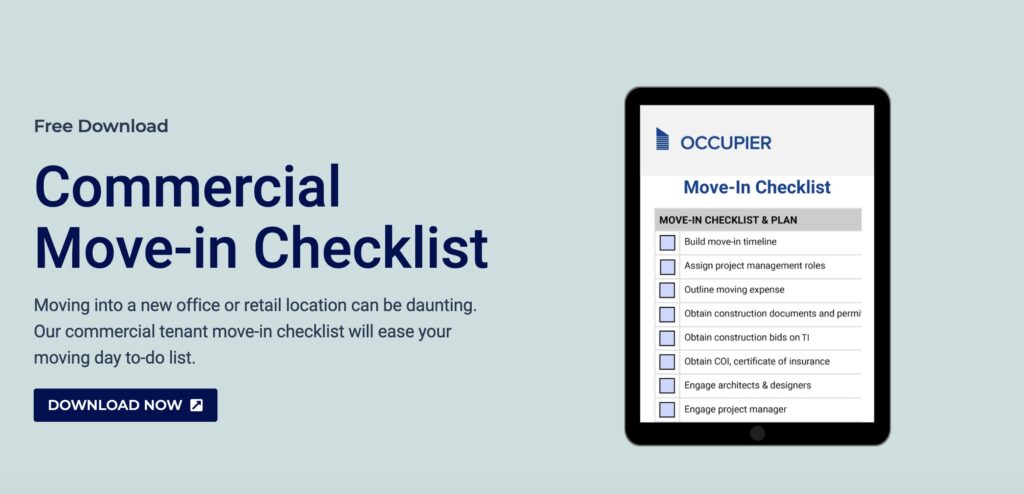Commercial Real Estate: A Tenant’s Guide to Subleasing Space
Last Updated on January 31, 2024 by Morgan Beard
Whether you’re looking to optimize your space, share costs, or adapt to changing circumstances, subleasing can be a beneficial solution. In this guide, we’ll take you through the ins and outs of subleased spaces providing commercial tenants like you with a comprehensive understanding of the sublease process,
What is Subleasing?
Subleasing is the practice where an existing tenant rents out part or all of their leased commercial space to a third party known as the subtenant. This arrangement involves a legal relationship that includes the original tenant, the landlord, and the subtenant. It’s a dynamic way to utilize unused or excess space effectively.
Reasons to Sublease
The motivations behind commercial subletting are diverse and often rooted in practicalities — evaluation of market conditions and/ or researching cost-effective solutions. You might choose to sublease if your business needs have evolved, leading to the desire for a smaller space or shared costs or supplemental rental income. Subleasing is also advantageous during temporary closures or when you’re exploring expansion possibilities without fully committing to a new lease.
Here are various scenarios where subleasing can prove advantageous for different types of commercial businesses:
Retailers
- Market Testing: Established retail chains may sublease space in a new location to test the local market before committing to a long-term lease. Short-term pop-ups are one example of a retail sublease contract type that empowers a retailer to explore new growth strategies.
- Adapting to Trends: Subleasing allows retailers to quickly adjust to changing trends or customer preferences without being tied to long-term financial obligations via a lengthy lease term.
Restaurants & Franchises
- Exploring New Locations: Restaurants with multiple locations can sublease in a new neighborhood to explore potential demand before opening a full-scale establishment.
- Expanding Menu Offerings: Subleasing a smaller space can be a strategic way to introduce a new concept or limited menu without substantial financial commitments or overhead.
Corporate Offices
- Project-Based Teams: Large corporations can sublease space to project-based start-up teams or high-growth companies to encourage innovation and collaboration within their established environment.
- Agile Expansion: Subleasing offers the flexibility for corporate offices to expand their footprint without committing to long-term leases, adapting to fluctuating workforce sizes, and reducing costs of larger office spaces.
Healthcare Institutions
- Specialized Services: Hospitals or healthcare centers with multiple locations can sublease to specialized practitioners, enhancing the range of medical services offered.
- Temporary Clinics: Subleasing provides healthcare providers the option to establish temporary clinics in areas with increased demand during specific seasons.
Co-Working Providers
- Flexible Offerings: Established co-working providers can sublease to startups or small businesses, offering them private conference rooms or full floors in order to meet the flexibility of their business. All while enjoying the amenities of a co-working space.
- Expanding Network: Subleasing allows co-working providers to expand their reach to new areas without the need for extensive build-outs.
Industrial and Warehousing
- Storage Solutions: Industrial businesses can sublease underutilized warehouse space. Commercial warehouse spaces often have a large footprint, so subletting allows you to grow into the space and share costs
- Temporary Overflow: Warehouses can sublease during peak periods to accommodate another businesses’ overflow.
Move-In Checklist
Steps to Subleasing
Understand the Lease Terms
Before delving into subleasing, carefully review your existing commercial lease agreements. Pay attention to the sublease clause, as your ability to sublease might be outlined explicitly or require landlord consent. Understanding these sublease terms will lay the foundation for a successful subleasing arrangement.
Obtaining Landlord Consent
Securing landlord permission is a pivotal step in subleasing. Before approaching your landlord, gather information about the subtenant, their business, updated rent schedules, and the terms of the sublease. Present a compelling case that demonstrates how subleasing benefits all parties involved.
Responsibilities of the Sublessor
As the original tenant (sublessor), your responsibilities extend to ensuring the subtenant’s adherence to the terms of the sublease. You’ll collect rent, maintain the property, and serve as a point of contact for any subtenant concerns.
Finding the Right Subtenant
Identifying the right subtenant is crucial for a successful subleasing experience. Seek out businesses that complement your industry or share similar values. Utilize marketing strategies to attract potential subtenants, including leveraging online platforms and industry networks.
Drafting a Sublease Agreement
Crafting a comprehensive sublease agreement is essential. This document should mirror the key terms of your original lease while incorporating specific details about the sublease arrangement — including rent terms, duration, responsibilities, shared areas, and any necessary co-tenancy clauses relevant to the subtenant’s use of the space.
Communication and Transparency
Clear communication with both the landlord and subtenant is vital. Maintain an open line of dialogue to prevent misunderstandings and address any concerns promptly. Transparency about expectations and responsibilities can pave the way for a harmonious subleasing experience.
Managing Subleasing Risks
While subleasing offers benefits, it’s not without risks. Be prepared to address potential challenges such as defaulting subtenants or conflicts over shared spaces. Mitigate these risks by establishing clear terms, conducting due diligence, and having contingency plans in place.
Legal Considerations
Understand that subleasing might be subject to local laws and regulations. Familiarize yourself with any legal requirements that could impact your subleasing arrangement. When in doubt, consult legal counsel and experienced commercial real estate professionals on the sublease market and sublease arrangement.
Exit Strategy
Plan for the end of the sublease agreement from the outset. Communicate with your subtenant well in advance of the termination date, ensuring adherence to the original lease’s termination procedures.
Subleasing Commercial Space Summarized
Subleasing is a dynamic strategy that empowers commercial tenants to optimize their space and create flexible terms in order to adapt to your changing business needs. By understanding the intricacies of subleasing, you’re equipped to make informed decisions that align with your goals. Remember that transparent communication, thorough documentation, and compliance with legal requirements are the cornerstones of a successful subleasing experience.
As a commercial tenant, your understanding of subleasing opens doors to flexibility and strategic growth. By navigating the subleasing landscape with care, you can leverage your space effectively while building positive relationships with both your landlord and subtenants.
Lease Accounting Resources
Check out our resource hub. We have the templates, spreadsheets, and calculators to help you manage entire lease lifecycle.

